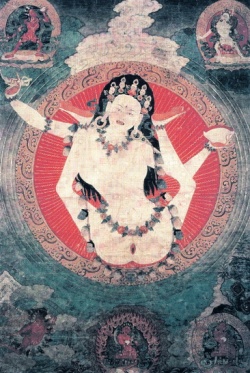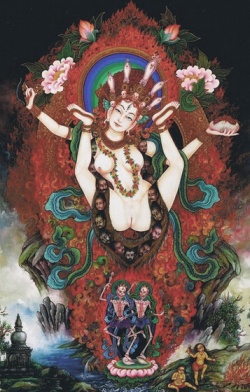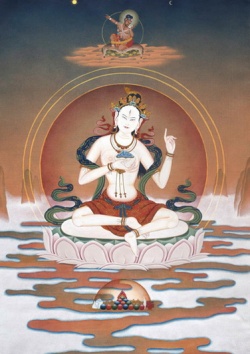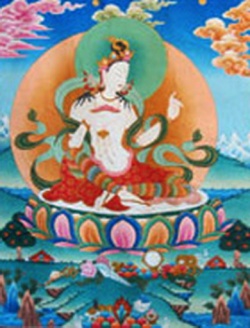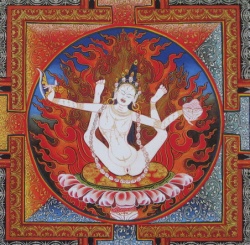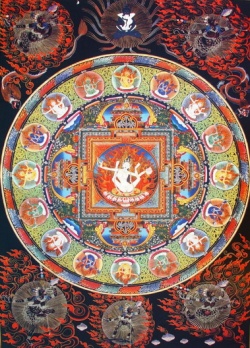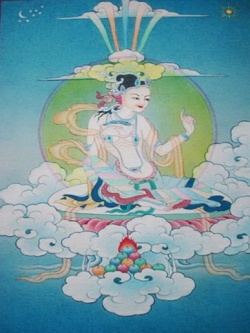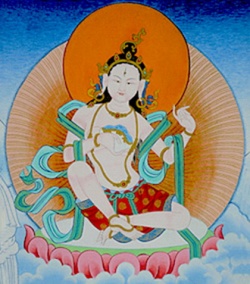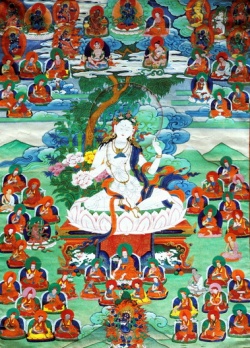The Story of Sukhasiddhi
"Give up the mind that wants to meditate and calm down. Focus on nothing at all.
Disturbing thoughts and lazy indifference are not liberation.
Remain unstained by thoughts and circumstances.
Rest relaxed in the uncontrived nature of mind, free of elaboration or alteration.
For the benefit of one and all, simply preserve peerless awareness."
~~ Sukhasiddhi
'The life story of Sukhasiddhi is very wonderful. When she was about sixty years old, or maybe sixty-five, she experienced a great deal of suffering. Due to that, she engaged in the practice of vajrayana and attained a state where she appeared like a sixteen-year-old girl. Her story is that she and her family were very poor and they got to the point where they only had one container of rice left. So, her husband and son went out to look for food. They went all over, searching, begging for food. Though they went through a great deal of difficulties, they were unable to find any food. Thinking that they had one container of rice left, they went back home to eat it. However, while they were gone, Sukhasiddhi, out of great compassion, had given the food to a beggar.
When her husband and son came back, they were very hungry and expecting to eat the last container of rice, but they found that there was no rice left, that she had given it away to a beggar. They were very upset and very angry with her, saying that though they were all experiencing a great deal of suffering, a great deal of problems, she had given their last food away. They were so upset with her that they threw her out of the house. Then she became very upset and cried about her husband and son throwing her out of her home. Leaving her town, she gave rise to a very strong renunciation for samsara, and based upon this very strong renunciation and good fortune, she was able to meet with a siddha from whom she received oral instructions.
She meditated upon them and realized mahamudrae supreme siddhi. Her mind was liberated within this state of luminosity, and her body became an empty form like a rainbow. She looked like a sixteen-year-old girl. She unified luminosity and the illusory body. It is said that even at this time she resides in India and can be found in various places there. So it is on the basis of having a lot of suffering and difficulties that one is able to practice the dharma very well. In order to meditate upon mahamudrae needs to have problems and difficulties. If one doesn't have problems, but is just happy, one won't meditate and will just be distracted.
Therefore, it is said that when one is meditating upon mahamudrat is very good if one has a lot of suffering. Within the true nature, or essence, of mahamudrae is no time, and therefore one does not need to think about needing a long time for these practices. It is enough just to realize the true nature of one's present mind, mahamudra.'
'The Story of Sukhasiddhi', as told by Khenpo Tsultrim Gyatso Rinpoche:
"Upon receiving empowerment and instruction from Virupa, Sukhasiddhi, then a sixty-one-year-old, attained full enlightenment that very evening. Like Niguma, her body became rainbowlike. Niguma is remembered as a wrathful, dark-brown woman who wore bone ornaments, whereas Sukhasiddhi is portrayed as a peaceful, light-skinned sixteen-year-old."
Sukhasiddhi's accomplishment equaled that of Niguma. Although they were both born in Kashmir, there is no record of any meeting between them. They are cited together only as teachers of the same disciple, Kyungpo Naljor, yet according to the Nyingma tradition, they are related from past lives. Jamgon Kongtrul writes in The History of the Sources of the Profound Treasures and the Treasure Revealers (p. 32b), that Niguma in a past life was none other than Mandarava, Guru Rinpoché's foremost Indian disciple. The identification of Sukhasiddhi with Yeshé Tsogyal, Guru Rinpoché's foremost Tibetan disciple, and with her reincarnation as Machik Labdrön, is well known.
Sukhasiddhi arrived at tantric Buddhism late in life. She lived as an impoverished housewife and mother of six children until the age of fifty-nine. She was thrown out of her home by her husband and children, who were irate at what they considered her misplaced generosity to a stranger who came begging at their door. She wandered westward to Oddiyana (Swat Valley in modern Pakistan), where she acquired a measure of grain, with which she made alcohol. Her business proved a modest success, and she allowed herself to again be generous, this time to a female adept referred to as Avadhuti-ma, who regularly bought alcohol for her companion, an adept in retreat.
Sukhasiddhi's gift of free alcohol intrigued the adept, Virupa, who asked whether his surprising benefactor wanted to receive Buddhist teaching. She did. Sukhasiddhi's story relates that she brought as offerings to Virupa two containers of alcohol and some pork. Although this meeting predates the Muslim domination of India, pork and alcohol were far from what would have normally constituted suitable offerings for spiritual teaching, even to tantric masters. Nevertheless, Virupa was no normal master, and Sukhasiddhi would prove an exceptional disciple.
Upon receiving empowerment and instruction from Virupa, Sukhasiddhi, then a sixty-one-year-old, attained full enlightenment that very evening. Like Niguma, her body became rainbowlike. Niguma is remembered as a wrathful, dark-brown woman who wore bone ornaments, whereas Sukhasiddhi is portrayed as a peaceful, light-skinned sixteen-year-old.
Niguma's teachings make up the bulk of the Shangpa Instruction Lineage's meditation practices, yet it is Sukhasiddhi who occupies the center of the sacred circle when Kyungpo Naljor's masters are recalled. Kyungpo Naljor himself testified to her central position, as quoted in The Story of the Wisdom Dakini, Sukhasiddhi, Whose Other Name [in Tibetan) is Déwé Ngödrub [[[Accomplishment]] of Bliss):
Among my four principal spiritual masters, Niguma, Rahula, the hidden yogi [probably Métripa], and Sukhasiddhi, the kindest was Sukhasiddhi. Her first great kindness was the bestowal of many transmissions. Her later great kindness was to be my secret consort and to grant me every empowerment. Her final great kindness was to give me directions for giving empowerment, along with profound instruction in meditation. Moreover, she said she would remain inseparable from me throughout India and Tibet, a very great kindness, and that meditators in future generations would gain accomplishment by experiential cultivation of this secret meditation she taught. (The Collection of Shangpa Masters' Biographies, pp. 56-57)
In fact, Sukhasiddhi kept her promise to appear to future lineage holders, notably to each of the first four lineage holders after Kyungpo Naljor, and has thereby revitalized and added to the Shangpa teachings over the centuries.
If we compare Niguma and Sukhasiddhi's contributions to the Shangpa lineage, Niguma's definitely outnumber those of Sukhasiddhi, but both taught Great Seal and a series of meditations called the Six Doctrines (each very different from the other and from those of Naropa, although the subjects are the same).
Niguma's and Sukhasiddhi's biographies have one thing in common. Both women reached as high a level of realization as any of the great Indian masters without the drama that we have come to associate with Dharma (Buddhist religious practice), particularly that of the early Marpa Instruction Lineage. In looking at the Marpa lineage masters' lives, we might wonder, "Does the path to enlightenment have to be so excruciating?" Niguma and Sukhasiddhi would answer, "No."
While it's true that Naropa and Milarepa in particular had difficult spiritual lives, we should recall that they were particularly difficult characters. Before his awakening, Naropa had been a brilliant Buddhist university professor, one of the best of his time. Yet his tight, solid, self-assured mind was so unfit for meditationr instruction in the mind's nature, that his teacher had him undergo hardships instead. For his part, Milarepa had practiced black magic and killed forty people before meeting his teacher.
Naropa and Milarepa were not average people and did not follow an average path to awakening. Their stories are well loved throughout the Himalayas, but Tibet's Buddhists also know many other "templates" for the path to enlightenment. While we might not be able to attain enlightenment in an evening or a week, as Niguma and Sukhasiddhi did, we can absorb that possibility into our outlook. Things can be light and easy—we receive pith instructions from a qualified teacher and we give ourselves permission to allow the teachings to guide us to awakening. It could be as simple as that. And so it was for our two uncomplicated, straightforward dakinis.
New Buddhist converts must confront the inevitable influence of their former religion's presentation of the spiritual path, which in the case of the Judeo-Christian tradition is not necessarily good news. Whether or not new Buddhists had actually practiced in that tradition, the pervasive influence of Judeo-Christian culture has given most of us a deep, reflexive expectation that a spiritual path will involve something along the lines of dark nights of the soul, suffering, painful ego death followed by glorious spiritual rebirth, and so on. While such a template seems incredibly dramatic and foreign to Buddhism, it is perfectly "normal" if we recall that Western culture, both religious and secular, has been deeply influenced by the idea of original sin, the opposite of Buddhism's intrinsic enlightenment or primordial purity. Niguma and Sukhasiddhi were unburdened by such debilitating expectations; they were "pure" Buddhists who did what all Buddhists should—they became pure buddhas. Fortunately for them and for us, no one told them that enlightenment was beyond them or that the path had to be long and arduous.
The Melody of Great Bliss: A Supplication to the Wisdom Dakini Sukhasiddhi
by Jamgon Kongtrul
Bestower of uncontaminated, coemergent bliss;
Radiant with the full splendor of sixteen-year-old youth;
Leader of every assembly of dakinis in the three locations—
Venerable Accomplishment of Bliss [[[Sukhasiddhi]]), to you I pray.
You manifested in a pauper's home in Kashmir
And trained in realization on the path.
Having completed the force of faith and great compassion,
You diligently gave gifts without attachment; to you I pray.
Millions of eons ago, you perfected the cultivation of merit and wisdom
And the result of your training manifested.
The awakening of your karmic connections
Made you renounce home life; to you I pray.
In the land of Oddiyana, source of great mysteries,
Men were spiritual warriors; women, female warriors.
Just by your reaching the center of that gathering,
The power of your enlightened potential awakened; to you I pray.
You demonstrated the skillful means of illusory conduct as a vendor of delicious alcohol.
You gave twice-strained rice alcohol to a female adept.
This created a connection through faith
With a tantric practitioner in the forest; to you I pray.
Noble Virupa accepted you as his disciple
And gave you the full four empowerments into secret practice.
Instantly, your ripened karmic body of sixty-one years
Became that of a sixteen-year-old maiden; to you I pray.
Taking the inner path, you truly traversed in a single moment
The major vajra stages of awakening,
And you appeared in an uncontaminated, vajra rainbow body.
Powerful one of the celestial realms, to you I pray.
You became the manifest form of coemergent wisdom, Buddha Selfless One,
To remain until the end of cyclic existence.
You watch over the three realms' beings during the six periods of day and night.
Honored female buddha, to you I pray.
You manifestly bless those who pray to you
And lovingly watch over your children who preserve your lineage, never parting from them.
You bestow common and supreme accomplishment in a matter of months or years.
Powerful one of great compassion, to you I pray.
Vajra Yogini, perfection of transcendent knowledge,
You appear to help beings in a body that has form.
The exquisite flower of your body, which one never tires of seeing,
Blooms with the marks and signs of physical perfection; to you I pray.
In the Teaching's infinite gates, which have the nature of emptiness,
You speak according to beings' dispositions.
Your speech, invincible sweet sound in every situation,
Flows imbued with the sixty tones of Brahma's voice; to you I pray.
Inseparable bliss and emptiness, the true vajra of space,
Pervades all animate and inanimate life.
Your sublime enlightened mind of luminous Great Seal
Is coemergent and uncontaminated; to you I pray.
Epitome of the qualities of freedom and maturity,
You have an inconceivable life.
Just hearing your voice inspires uncontaminated bliss.
Sublime wish-fulfilling jewel, to you I pray.
You unite in pleasure with all victors and bodhisattvas.
Your emanations reach the four elements' limits.
Like an excellent vase, a gem, or a wish-fulfilling tree,
Your enlightened activity is spontaneously present; to you I pray.
Your compassion knows no distance and embraces all equally.
You guide fortunate persons on the path to the celestial realms.
Your loving face wears the conscientious smile of compassion.
Friend to all beings, to you I pray.
To your child who preserves the lineage and who prays to you,
Show your loving face and joyfully grant me your supreme prophecy.
Bestow the empowerment of great vajra wisdom,
And bless me that I merge inseparably with you.
Excerpted from Timeless Rapture, by Ngawang Zangpo.
